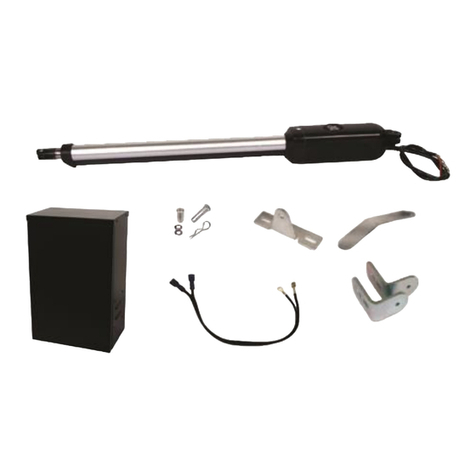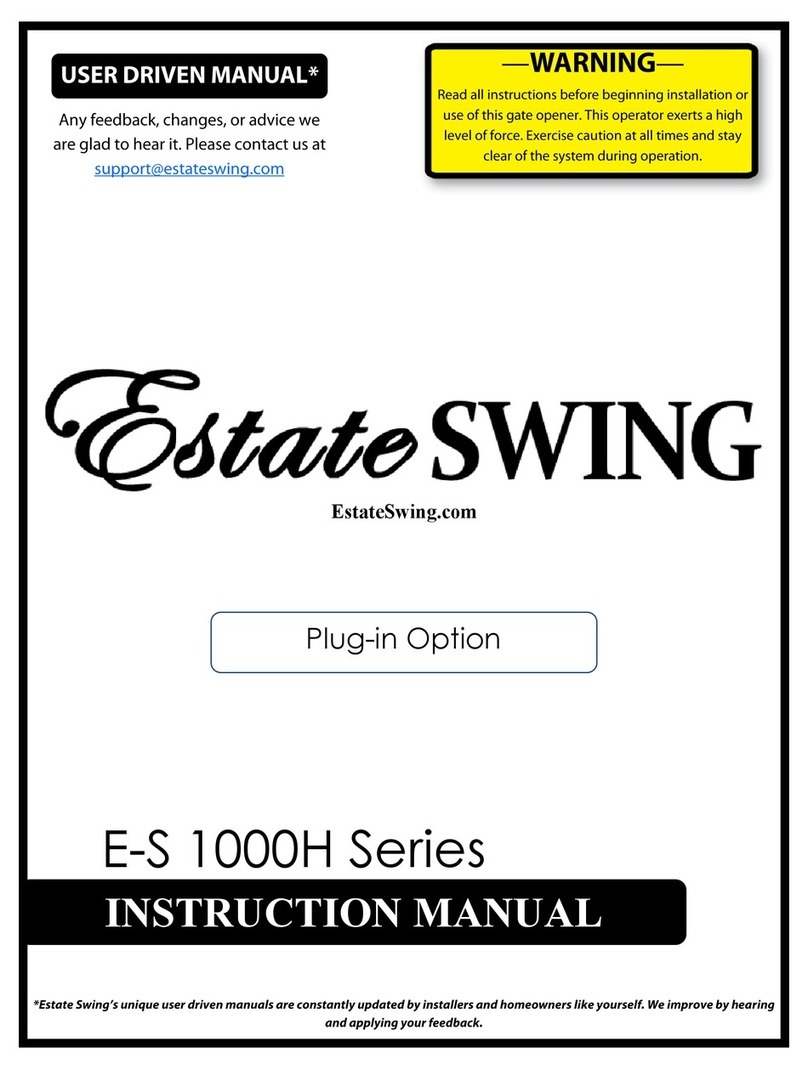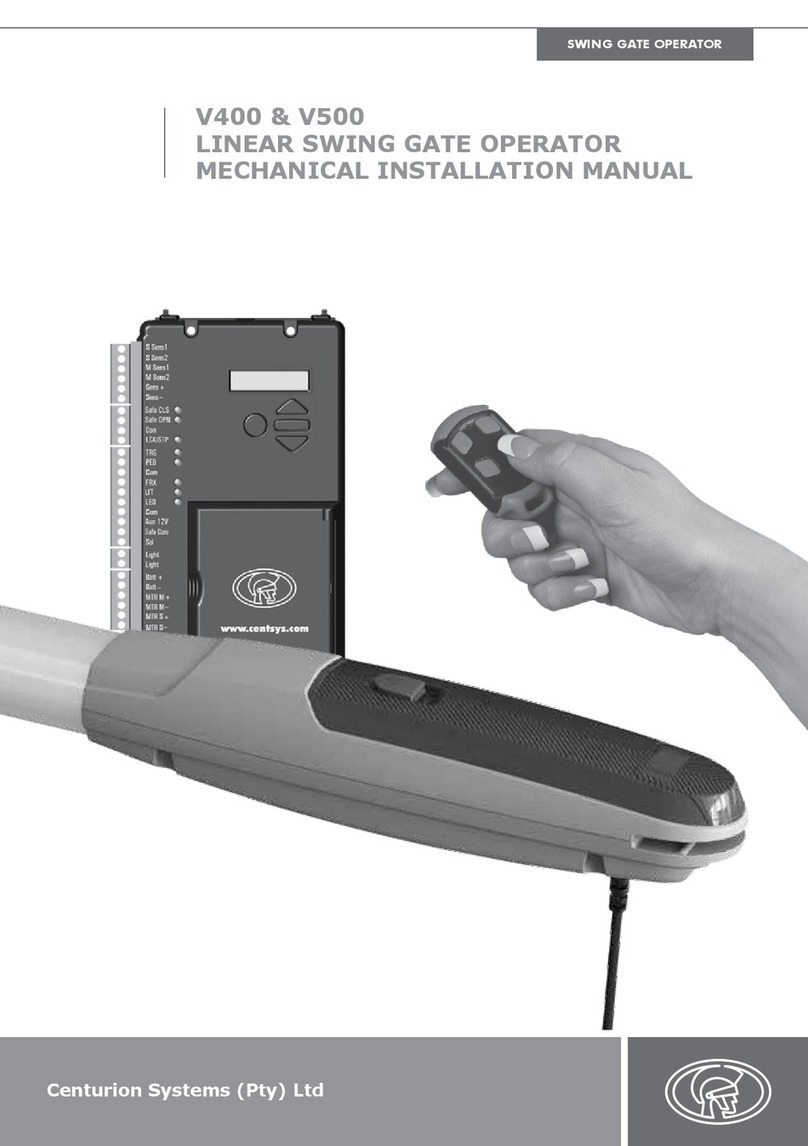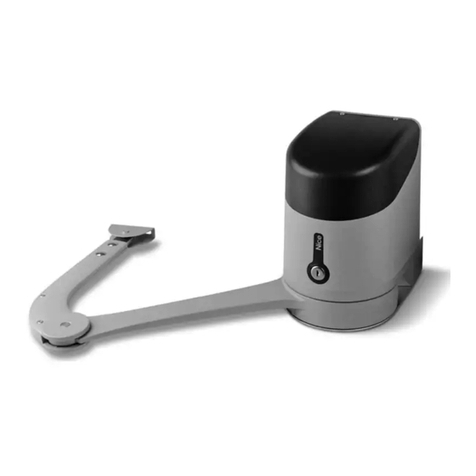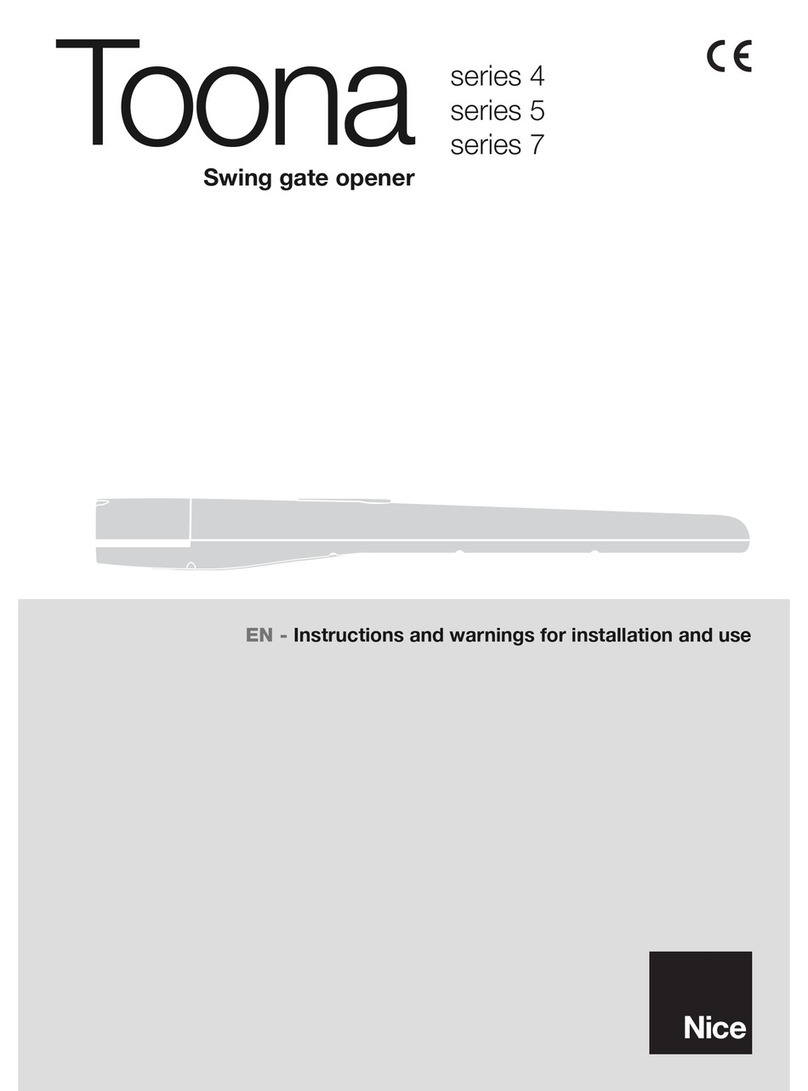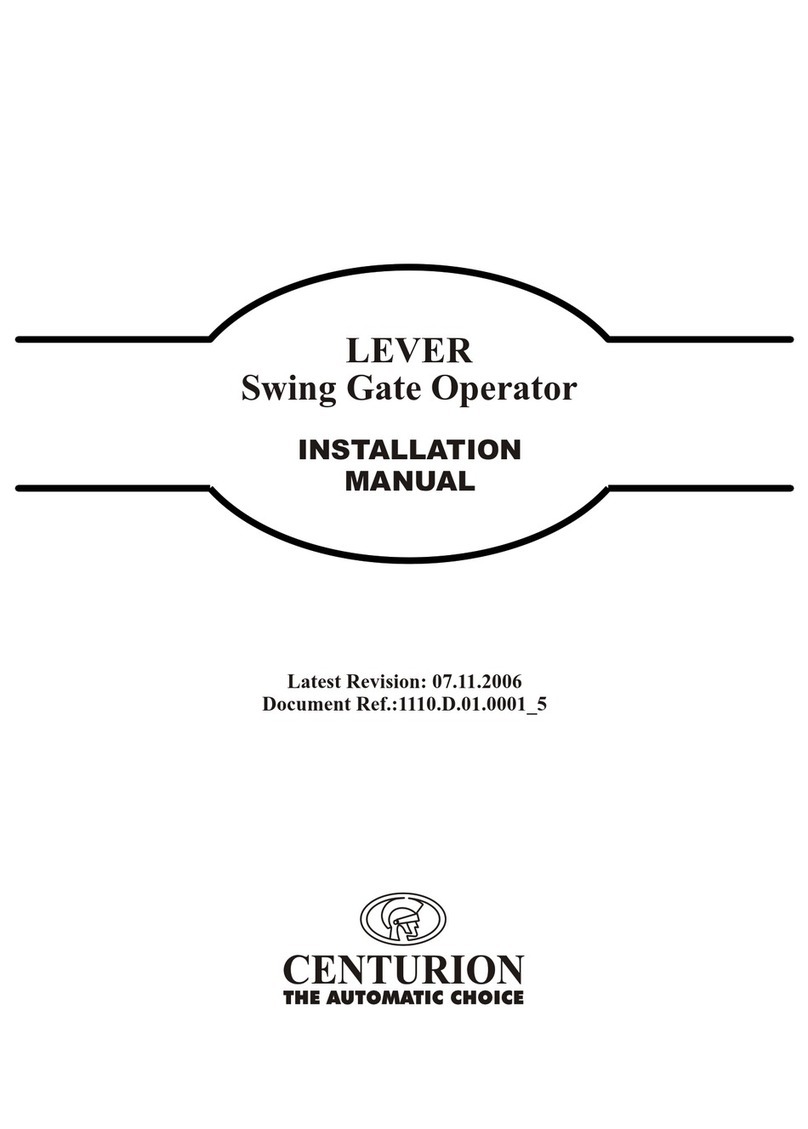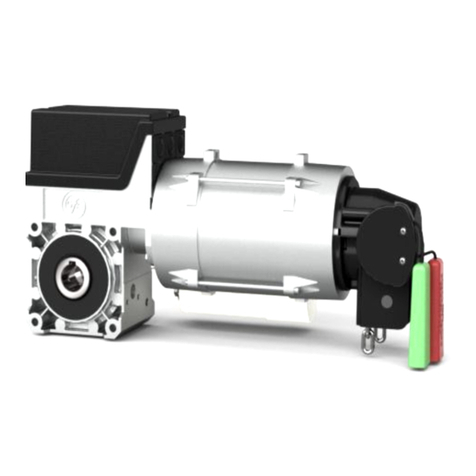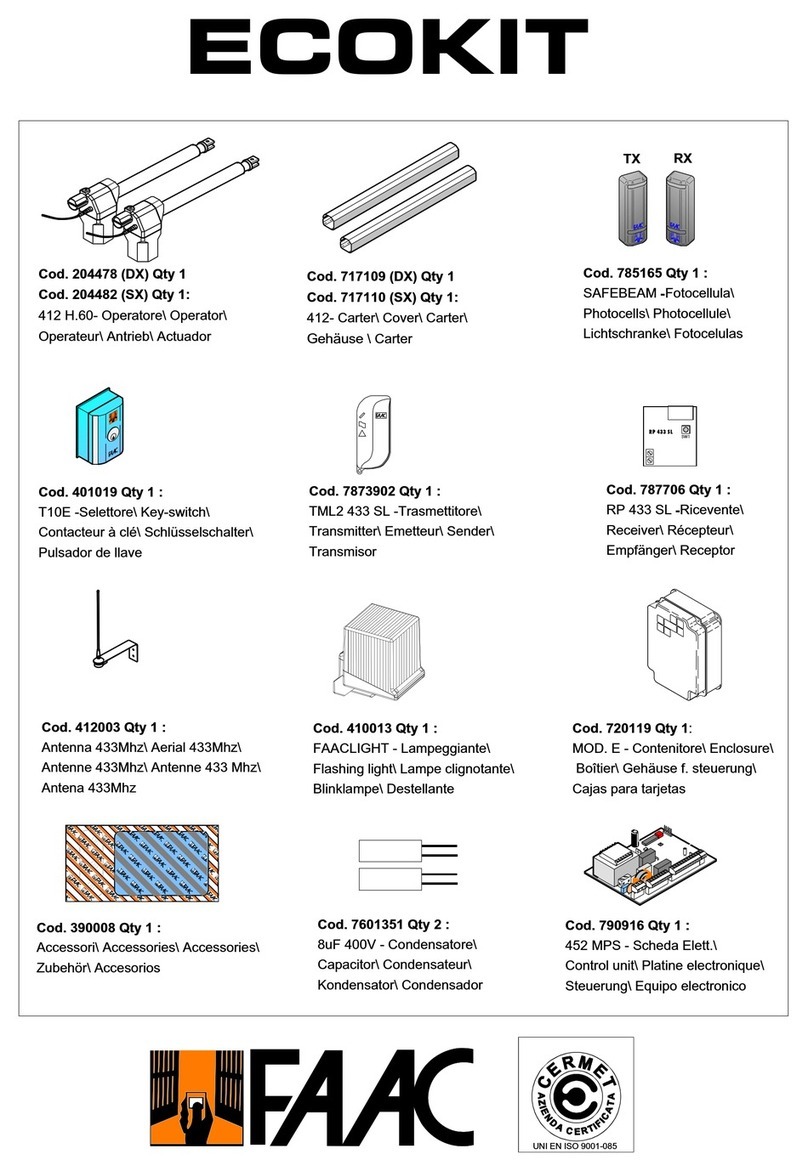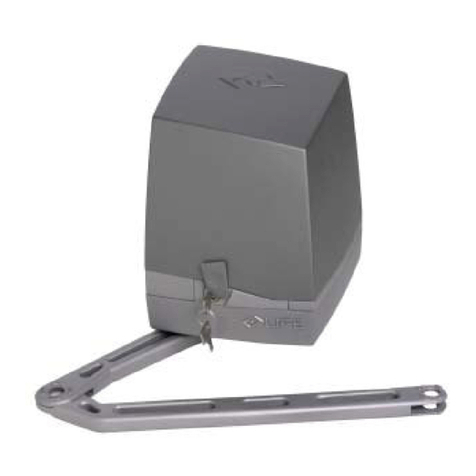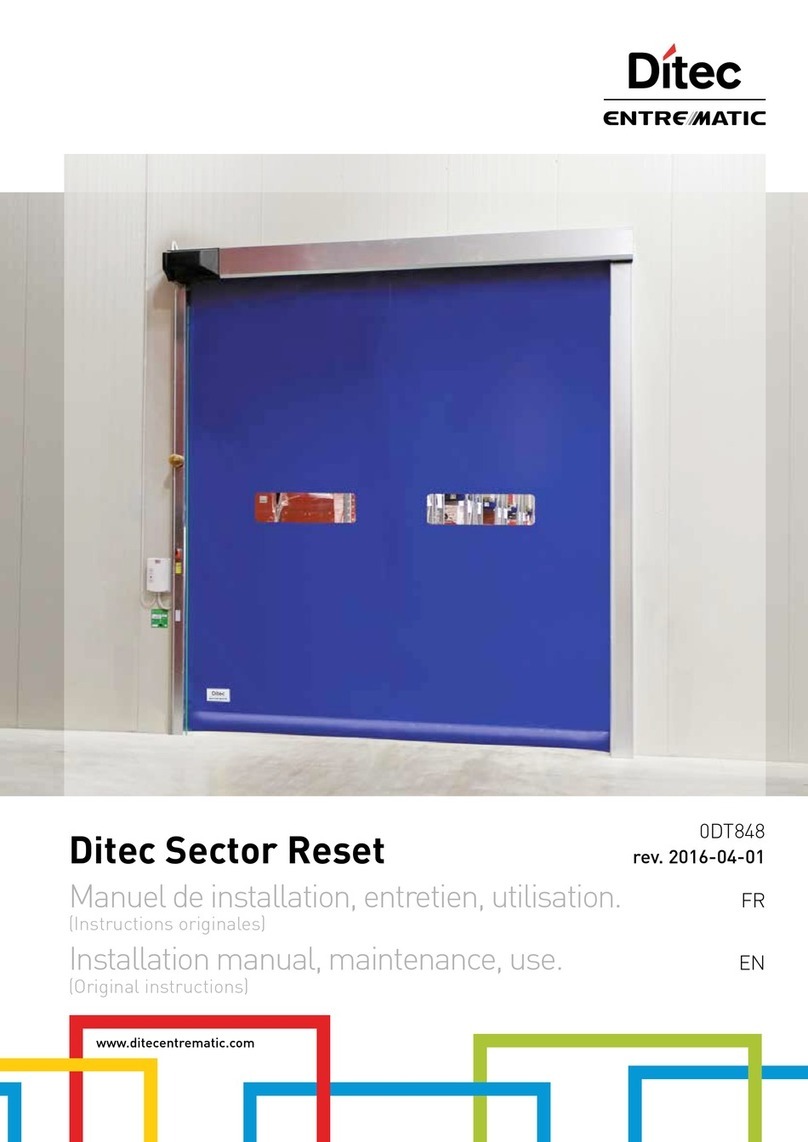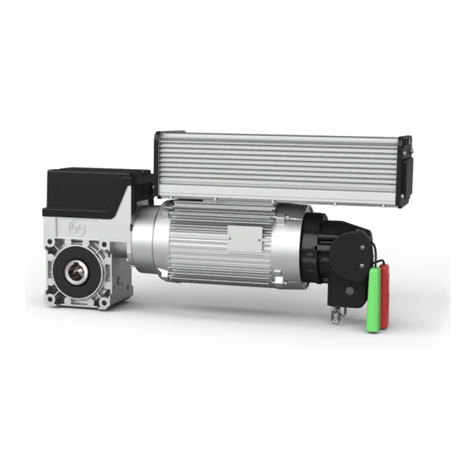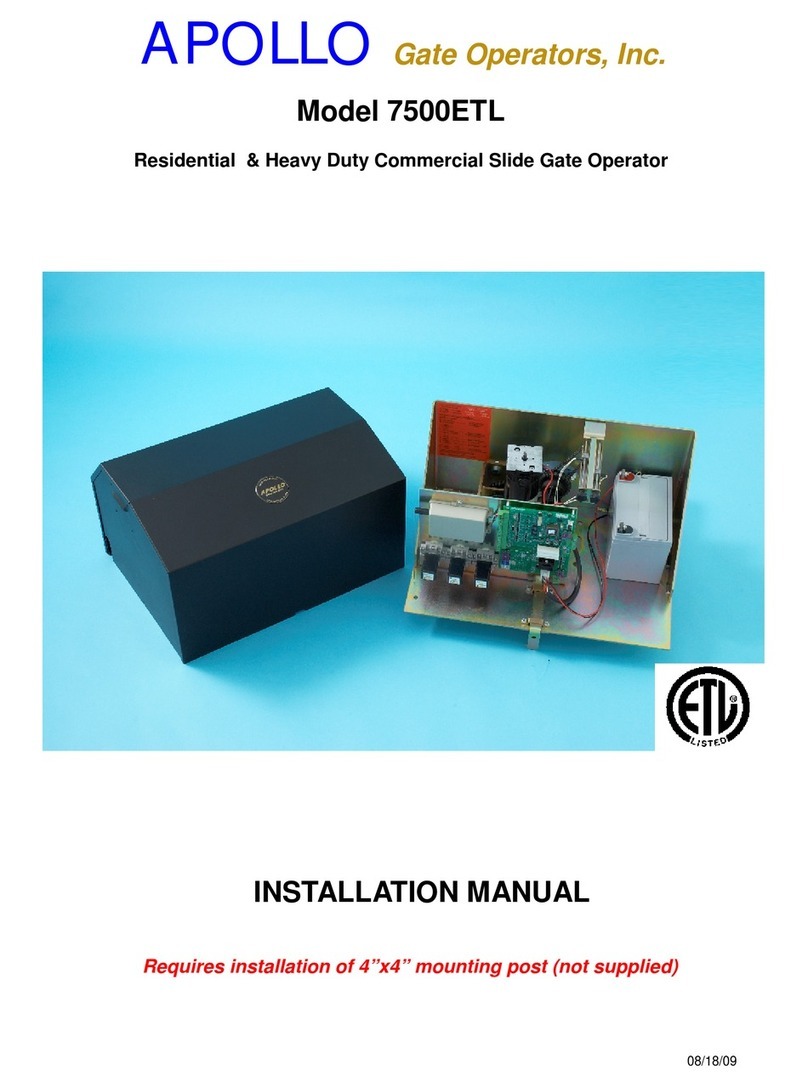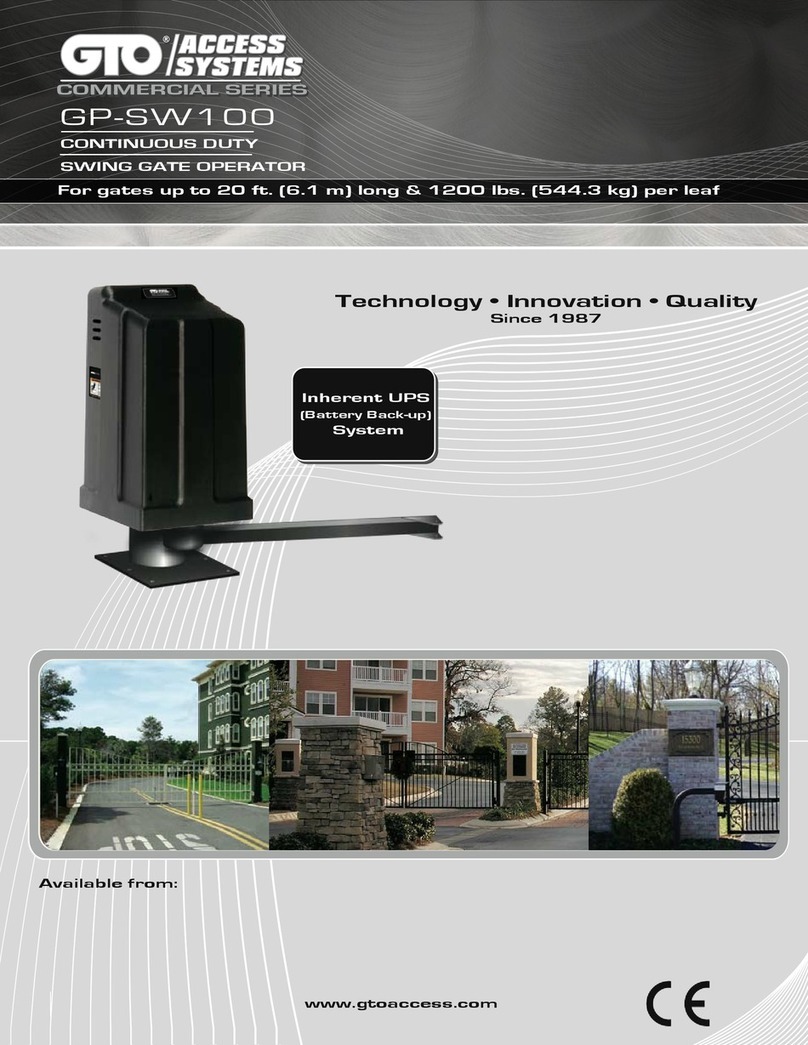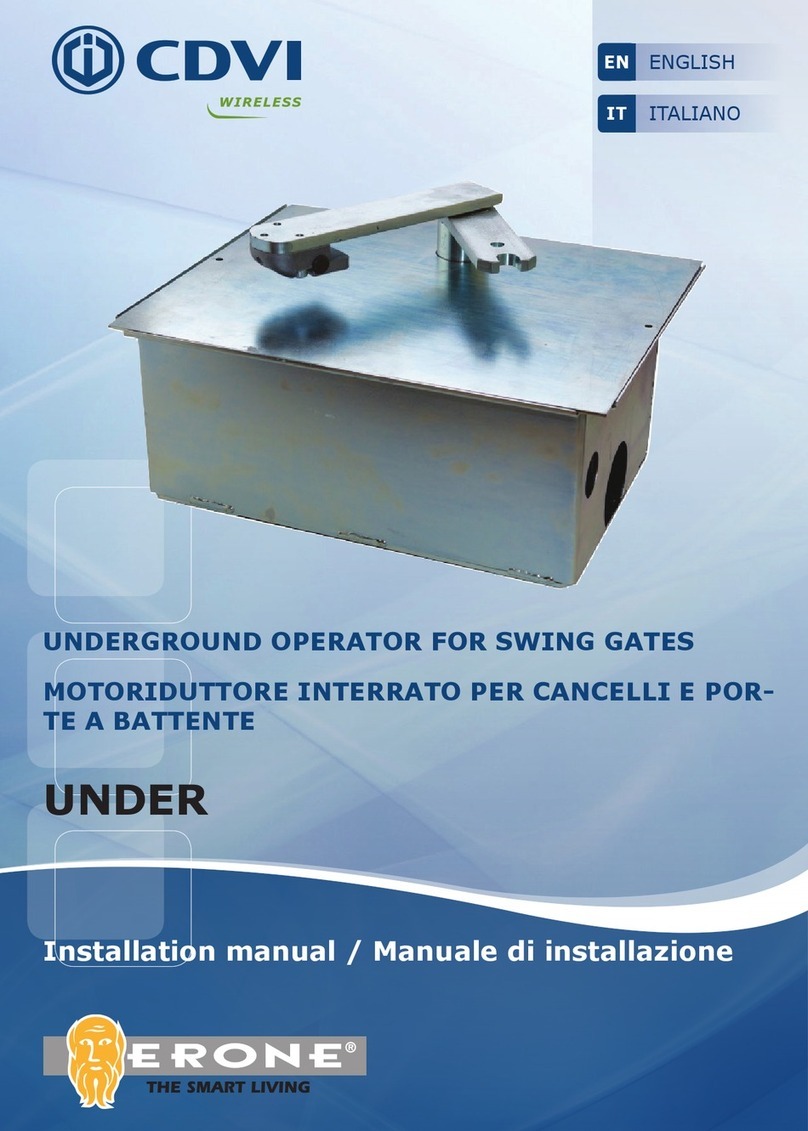Estate Swing E-S 1600 Series User manual

Instruction Manual for the
E-S 1600/ E-S 1602 / E-S 1600L /
E-S 1602L Series

CE DECLARATION OF CONFORMITY OF MACHINES
(Directive 89/392/EEC, Annex II, Part B)
Manufacturer: FAAC S.p.A.
Address: Via Benini, 1 – 40069 Zola Predosa Bologna – Italy
Declares that: 409 A.K.A. Estate Swing (USA) mod operator
Is built to be integrated into a machine or to be assembled with other machinery to create a machine under the provisions
of Directive 89/392/EEC, and subsequent amendments 91/368/EEC, 93/44/EEC.
Conforms to the essential safety requirements of the following EEC directives:
o73/23/EEC and subsequent amendment 93/68/EEC, 89/336/EEC and subsequent amendment 92/31/EEC and
93/68/EEC.
oAnd also declares the it is prohibited to put into service the machinery until the machine in which it will be
integrated or of which it will become a component has been identified and declared as conforming to the
conditions of Directive 89/392/EEC and subsequent amendments assimilated under national laws under DPR
#459 of July 24, 1996.
Bologna, January 1, 2002
Managing Director
A. Bassi
Warnings for the installer
General safety obligations
Abassi
1. Attention! To ensure the safety of people, it is important that you read all the following instructions. Incorrect installation or incorrect
use of the product could cause serious harm to people.
2. Carefully read the instructions before beginning to install the product.
3. Store these instructions for future reference.
4. This product was designed and built strictly for the use indicated in the documentation. Any other use, not expressly indicated here,
could compromise the good condition/operation of the product and/or be a source of danger.
5. FAAC declines all liability caused by improper use or use other than that for which automated system was intended.
6. Do not install the equipment in an explosive atmosphere; the presence of inflammable gas or fumes is a serious danger to safety.
7. The mechanical parts must conform to the provisions of Standards EN 12604 and EN 12605.
For non-EU countries, to obtain an adequate level of safety, the standards mentioned above must be observed, in addition to national
legal regulations.
8. FAAC is not responsible for failure to observe Good Technique in the construction of the closing elements to be motorized, of for any
deformation that may occur during use.
9. The installation must conform to Standards EN 12453 and EN 12445.
The safety level of the automated system must be C+D.
10. Before attempting any job on the system, cut out electrical power and disconnect the batteries.
11. The main power supply of the automated system must be fitted with an all-pole switch with contact opening distance of 3 mm or great-
er. Use of a 6A thermal breaker will all-pole circuit break is recommended.
12. Make sure that a differential switch with threshold of 0.03 A is fitted upstream of the system.
13. Make sure that the earthing system is perfectly constructed, and connect metal parts of the means of the closure to it.
14. The automated system is supplied with an intrinsic anti-crushing safety device consisting of a torque control. Nevertheless, its tripping
threshold must be checked as specified in the Standards indicated at point 10.
15. The safety devices (EN 12978 standard) protect any danger areas against mechanical movement risks, such as crushing, dragging, and
shearing.
16. Use of at least one indicator-light (e.g. FAACLIGHT 12VDC) is recommended for every system, as well as a warning sign adequately
secured to the frame structure, in addition to the devices mentioned at point “15”.
17. FAAC declines all liability as concerns safety and efficient operation of the automated system, is system components not produced by
FAAC are used.
18. For maintenance, strictly use original parts by FAAC.
19. Do not in any way modify the components of the automated system.
20. The installer shall supply all information concerning manual operation of the system in case of an emergency, and shall hand over to
the user the warnings handbook supplied with the product.
21. Do not allow children or adults to stay near the product while it is operating.
22. Keep remote controls or other pulse generators away from children, to prevent the automated system from being activated involuntari-
ly.
23. Transit through the leaves is allowed only when the gate is fully open.
24. The user must not attempt any kind of repair or direct action whatever and contact qualified personnel only.
25. Do not short-circuit the poles of the batteries and do not try to recharge the batteries with power supply units other than Primary or
Secondary cards.
26. Do not throw exhausted batteries into containers for other waste but dispose them in the appropriate containers to enable them to be
recycled.
27. Anything not expressly specified in these instructions is not permitted.

Estate Swing Summary of Functions
The Estate Swing is only to be used for vehicular swing gates in a Class I
setting.
Class I: A vehicular gate opener (or system) intended for use in a home of
one-to-four single family dwelling, or a garage or parking area associated
therewith.
The FAAC Estate Swing automated system was designed and built for controlling
vehicle access. Do not use for any other purpose.
The external automation with an electro-mechanical non-reversing linear arm
automates residential swing-leaf gates with leaves of up to 16’ in length. It
consists of an irreversible electro-mechanical operator with built in opening and
closing limits and utilizes a worm screw system. The irreversible system ensures
the gate is mechanical locked when the motor is not operating. A lock still needs to
be installed if security or high winds are a concern. A manual release makes it
possible to move the gate in the event of a power-cut or fault.
Keep this manual safely stored after
installation.
Serial Number__________________________
Date of Purchase_______________________
Place of Purchase______________________
Have this information on hand while handling all
service and warranty issues.
This manual and its contents are produced by Web Direct Brands, Inc.

Table of Contents
The table of contents are listed to assist you locating a desired section. We do howev-
er strongly suggest studying every page of the instruction manual before attempting
installation.
SECTION:
Review of specifications, warnings, and tools 1
Specifications of the Estate Swing and Components 1.1
Parts List 1.2
System Overview & Preliminary Checks 1.3
Tools Needed for Installation 1.4
Installation 2
Manual Operation, Restoring Automation 2.1
READ FIRST: Determining Push or Pull to Open 2.2
IMPORTANT: Determining Setback—Pull to Open 2.3
Installation of Operator—Pull to Open 2.4-.7
IMPORTANT: Determining Setback—Push to Open 2.8
Installation of Operator—Push to Open 2.9-.12
Easy Wiring Under Driveway 2.13
For Your Convenience 2.14
Wiring, Jumpers and Receiver 3
Wiring Operator Arm(s) - Pull to Open 3.1-.3
Wiring Operator Arm(s) - Push to Open 3.4-.5
Temporary Safety Jumpers and Dip Switch Settings 3.6
Power 3.7
Limit Switches 4
Fine Tune Limit Switch - Pull to Open 4.1-.2
Fine Tuning Limit Switch - Push to Open 4.3

Table of Contents
Marks pages with opener or usage warnings. Although we have marked these as very
important warnings, please read the entire manual. Every step is important to the
correct installation of your gate opener.
The table of contents are listed to assist you locating a desired section. We do howev-
er strongly suggest studying every page of the instruction manual before attempting
installation.
SECTION:
Diagnostics 5
First Run & Parameters 5.1-.2
Plug-in Receiver 5.3-.4
Maintenance and Trouble Shooting
Bracket Maintenance 6.1
Troubleshooting 6.2-.5
Accessories 7
Control Board Overview 7.1-.4
Accessories 7.5-.6

MODEL Estate Swing
Power Supply
Rated Absorbed Power (W)
Current (A)
Travel (in.)
Cycles per hour
Operating Ambient Temp
Protection class
Gate leaf max length (ft.)
Gate leaf max weight (lbs.)
Operator overall dimensions LxHxD(in.)
Operator Weight
115V AC/ 24V AC
70
3
11
Continuous Duty / Aprox. 75
-4 to 131 F
IP44
Up to 14 (L-series: up to 20)
Up to 800 (L-series: up to 1000)
See below
18 lbs (L-series: 19 lbs)
Specifications
1.1
E-S 1600L arm
E-S 1600 arm

1.2
Estate Swing Parts List
B. Operator Arm with 33' (45')
of 5 Conductor Wire
G. Gate Mounting Bracket
H. Post Mounting Brackets
I. Mounting Hardware
1 - 3/8”x1 1/2” Hex bolts, washer,
nut 1 - 5/16”x1 1/2” Hex bolt,
washer, nut 2 - 3/8”x2” Carriage bolt,
washers, nut 1 - 1/4”x2” Hex bolt,
washers, nut
Secondary Operator (If Applicable)
A. Control Box
B. Operator Arm with 6' of 5 Conductor Wire and
Key
C. Control Board
D. Transmitter
E. Receiver
F. Transformer
G. Gate Mounting Bracket
H. Post Mounting Brackets
I. Mounting Hardware
1 - 3/8”x1 1/2” Hex bolts, washer, nut
1 - 5/16”x1 1/2” Hex bolt, washer, nut
2 - 3/8”x2” Carriage bolt, washers, nut
1 - 1/4”x2” Hex bolt, washers, nut
Primary or Single Operator

Standard System
Overview and Safety Zones
The system display to the below is a
recom-mended standard system. Other
approved accessories can be installed.
Photo sensors and a flashing light
indicating gate move-ment is
recommended for safety purposes.
IMPORTANT
Preliminary Checks:
To ensure safety and an efficiently operating automated system, make sure the
following condi-tions are observed.
The gate and post must be suitable for being automated. Check that the structure is
sufficiently strong and rigid, and its dimensions and weights conform to those
indicated on page 1.
Make sure the leaves move smoothly without any irregular friction during entire travel.
Make sure the hinges are in good condition. Ball bearing hinges are ideal for gates
weighing over 200 lbs. or over 10’ in length.
Make sure the gate is plumb and level.
The fence post must be secured in the ground with concrete. This will
prevent alteration of alignments and leveling during installation and
during cycles.
1.3
1,2 Estate Swing Operator
3 Photocells (not included)
4 Control board
5 N/A
6 Push button opening device (not included)
7 Receiver extension (not included)
8 12Vdc flashing lamp (not included)
9 Positive stop
10 DC transformer
Notes:
1) When laying electrical cables, use appropriate rigid and/or
flexible tube.
2) Do not run any wires in the same conduit as 110 AC
power that may be in the area. This will cause unwanted
interference.

Tools Needed
Power Drill
Crescent Wrench
Flat Head Screwdriver
Hacksaw
Phillips Head
Screwdriver
C-Ring Pliers
Tape Measure
Level
Wire Strippers
C-clamps
3/8”, 1/4”, 5/16” Drill Bits
Other items that may be needed prior to commencing installation. Bolded items are
necessary to all applications.
Start and stop post, bracket or door stop. Although the FAAC Estate swing 1600
features built in limit switches some may choose to use positive stops:
16, 14 or 12 gauge, 2 conductor stranded direct burial low voltage wire will be
required to run power to your operator. Length is deter mined by distance
between transfor mer power supply and the control box.
4 - 3/8” Bolts will be needed to connect the 2 “L” shaped brackets to the
post. Length will be determined by the size of your posts.
A metal support bracket may be needed to achieve the appropriate desired setback.
The metal support bracket will be bolted or welded to your post to give a larger
amount of space to mount the provided mounting bracket.
A voltage meter and digital camera will be necessary to run diagnostic checks.
If your transformer is going to be plugged into an outdoor outlet you will need to
weatherproof that outlet and transformer. Electrical boxes or plug covers can be
obtained from a local hardware store to accommodate both the plug and transformer.
Hardware to attach the control box to a post or fence.
Connectors for running wires into the control box.
Protect all ingoing and outgoing wires with a surge suppressor. Consult your local
dealer for more information.
1.4

Manual Operation Mode
1)
2) Remove rubber cover
3) Insert key and turn it 90 degrees.
4) Flip release lever up.
To exit manual mode, reverse the above steps.
2.1

The following section is instructions on
mounting your gate opener. Your gate can
be mounted one of two ways:
Pull-To-Open: With the gate opener on the inside of the
property, the gate will swing in towards the property. The
gate opener will be extended in the gate’s closed
position and as the opener retracts it PULLS the gate
open.
Instructions are pages 2.3 - 2.7
Push-To-Open: With the gate opener on the inside of the
property, the gate will swing out away from the property
towards the street. The gate opener will be
retracted in the gate’s closed position and as the opener
extends it PUSHES the gate open.
Instructions are pages 2.8 - 2.12
After deciding which method you will use
to automate your gate, make an X across
the pages of the installation method you
will
not
be using.
This will prevent mistakenly using the wrong instructions
for your installation as the two sections look very similar.
2.2

IMPORTANT: Determining Correct Setback
2.3
PULL TO OPEN - Standard operation. This means the gate operator is
mounted on the inside of the property and pulls your gate in towards the property.
To determine the position of the gate
mounting bracket (above is for the post
mounting bracket) re-fer to step 9 in the
section “Installation of operator”
A B a
6” 6” 90o
5.5” 5.5” 100o
There are 4 factors to keep in mind when finding the setback mounting:
1) The (A) measurement is perpendicular from the gate in the CLOSED position.
2) There must be clearance for your gate opener to attach to the gate in the closed position.
This is most commonly an issue on columns. Re-positioning of the hinges or Push-To-Open
operation may be required to achieve clearance.
3) The brackets do not and must not move after installation.
4) The "L" shape brackets can be mounted anywhere on the post or column. They can be
mounted on a separate post or fence as well. The only factor of importance is that when
mounting of the brackets is done the hole in the boomerang bracket that the gate opener mounts
on matches the setback on this page.
It is best to C-Clamp brackets on and test arm movement clearance before permanently attaching
them.

Installation of Operator—Pull-to-Open
2.4
2. Cut off the excess
length (if any) of the
angled brack-et using a
hacksaw.
3. Position the angled
brack-et between the two
“L” shaped brackets in the
same position as when
the setback was found.
Clamp the 3 brackets
together. Drill through the
angled bracket using the
pre-drilled holes in the “L”
shaped brackets us-ing a
3/8” drill bit. Drill through
all three brackets using a
5/16” drill bit in a position
behind the first hole.
4. Insert a 3/8” x 1” bolt
in the center hole and a
5/16” bolt in the rear
hole. Secure them using
the provided nuts and
lock washers.
1. Find the proper set back for your operator (from
previous page). Do this by holding the bottom “L”
shaped bracket against the post. Marking its horizontal
positioning on the post using a vertical line up from the
middle of the bracket. Also mark your angled bracket
for positioning on the “L” shaped bracket. The hole on
the end of the angled bracket should be in the setback
position.
HINT: Trace the bracket on cardboard and use the
cardboard to make a template.
Before permanently attaching any brackets, be sure to test
arm motion and clearance.
For full capacity, the amount of stainless steel showing retracted shovel be
between 2 1/4 - 3 inches and 15 1/4 - 16 1/2 inches when extended (L-series: 20
- 21 1/4 inches when extracted).

5. Temporarily position the gate side
mounting bracket. (horizontal position
does not matter, vertical position on
the gate is the position you are
matching to the post bracket.) Position
your assembled gate mounting along the
previouslydrawn vertical line and level the
angled piece with the horizontal piece of
the gate mounting bracket using a level.
Mark your holes, drill and attach the
brackets using (4) 3/8” carriage bolts.
6. Assemble the rear fitting to the operator as shown below
2.5
7. Run the 5 wires from the arm(s) to the control board as seen in section 3.
8.Set the operator for manual operation. And extend the operator arm to a near full
extended position.

2.6
9. Extend the operator arm so the measurement between the center of the pivot hole
on the rear bracket and the center of the pivot hole in the front mounting measures 51
1/4 inches (63 inches for L-series). After finding the measurement relock your
operator arm.
This is your closed mounting position.
10.Assemble the front gate mounting bracket as shown below. (bottom ring can
be left off if security is not a concern)
11.Attach the operator to the post mounting bracket using the supplied pins as shown
below, support the arm to prevent dropping and breakage of the rear fitting. (bottom ring
can be left off if security is not a concern)
E-S 1600 arm
E-S 1600L arm

2.7
Manually test the gate by completely
opening and closing it, checking for
smooth operation.
Gate in Closed position
12. Close the gate leaf. With the operator attached on the post side, move the end of
the arm to the gate and, keeping the gate operator in a perfectly horizontal position,
determine the gate mounting position. The arm should already be in it’s full closed length
that was determined in step 9
13. Attach the gate mounting bracket
using carriage bolts, nuts, and washers.
14. Release the gate operator once
more.

2.8
IMPORTANT: Determining Correct Setback
PUSH TO OPEN - This operation is commonly used if you driveway slopes up
after the gate, preventing it from swinging in. This means the gate operator is
mounted on the inside of the property and pushes your gate out away from the
property.
A B a
6” 6” 90o
5.5” 5.5” 100o
To determine the position of the
gate mount-ing bracket (above is
for the post mounting bracket) refer
to step 9 in the section
“Installation of operator - PTO”
There are 4 factors to keep in mind when finding the setback mounting:
1) The (A) measurement is perpendicular from the gate in the CLOSED position.
2) There must be clearance for your gate opener to attach to the gate in the closed position.
This is most commonly an issue on columns. Re-positioning of the hinges or Push-To-Open
operation may be re-quired to achieve clearance.
3) The brackets do not and must not move after installation.
4) The "L" shape brackets can be mounted anywhere on the post or column. They can be
mounted on a separate post or fence as well. The only factor of importance is that when
mounting of the brackets is done the hole in the boomerang bracket that the gate opener
mounts on matches the setback on this page.
It is best to C-Clamp brackets on and test arm movement clearance before permanently attaching
them.

Installation of Operator—Push-to-Open
1. Find the proper set back for your
operator (from previous page). Do this by
holding the bottom “L” shaped bracket
against the post. Marking its horizontal
positioning on the post using a vertical line
up from the middle of the bracket. Also mark
your angled bracket for posi-tioning on the
“L” shaped bracket. The hole on the end of
the angled bracket should be in the setback
position.
HINT: Trace the bracket on cardboard
and use the cardboard to make a
template.
Before permanently attaching any brackets, be sure to test arm
motion and clearance.
2.9
4. Insert a 3/8” x 1” bolt
in the center hole and a
5/16” bolt in the rear
hole. Secure them using
the provided nuts and
lock washers.
3. Position the angled
brack-et between the two
“L” shaped brackets in the
same position as when
the setback was found.
Clamp the 3 brackets
together. Drill through the
angled bracket using the
pre-drilled holes in the “L”
shaped brackets using a
3/8” drill bit. Drill through
all three brackets using a
5/16” drill bit in a position
behind the first hole.
2. Cut off the excess
length (if any) of the
angled brack-et using a
hacksaw.
For full capacity, the amount of stainless steel showing retracted shovel be
between 2 1/4 - 3 inches and 15 1/4 - 16 1/2 inches when extended (L-series: 20
- 21 1/4 inches when extracted).

5. Temporarily position the gate side
mounting bracket. (horizontal
position does not matter, vertical
position on the gate is the position
you are matching to the post
bracket.) Position your assem-bled
gate mounting along the previously
drawn vertical line and level the angled
piece with the horizontal piece of the
gate mounting bracket using a level.
Mark your holes, drill and attach the
brackets using (4) 3/8” carriage bolts.
6. Assemble the rear fitting to the operator as shown below.
7. Run the five wires from the arm(s) to the control board as seen in section 3.
8. Set the operator for manual operation. And extend the operator arm slightly
past the full retracted position..
2.10

2.11
9. Retract the operator arm so the measurement between the center of the pivot hole
on the rear bracket and the center of the pivot hole in the front mounting measures 36
inches (41 inches for L-series). After finding the measurement relock your operator
arm.
10. Assemble the front gate mounting bracket as shown below. (bottom ring can be left
off if se-curity is not a concern)
11.Attach the operator to the post mounting bracket using the supplied pins as shown
below, support the arm to prevent dropping and breakage of the rear fitting. (bottom
ring can be left off if security is not a concern)
This is your closed mounting position.
E-S 1600L
E-S 1600
Other manuals for E-S 1600 Series
1
This manual suits for next models
3
Table of contents
Other Estate Swing Gate Opener manuals
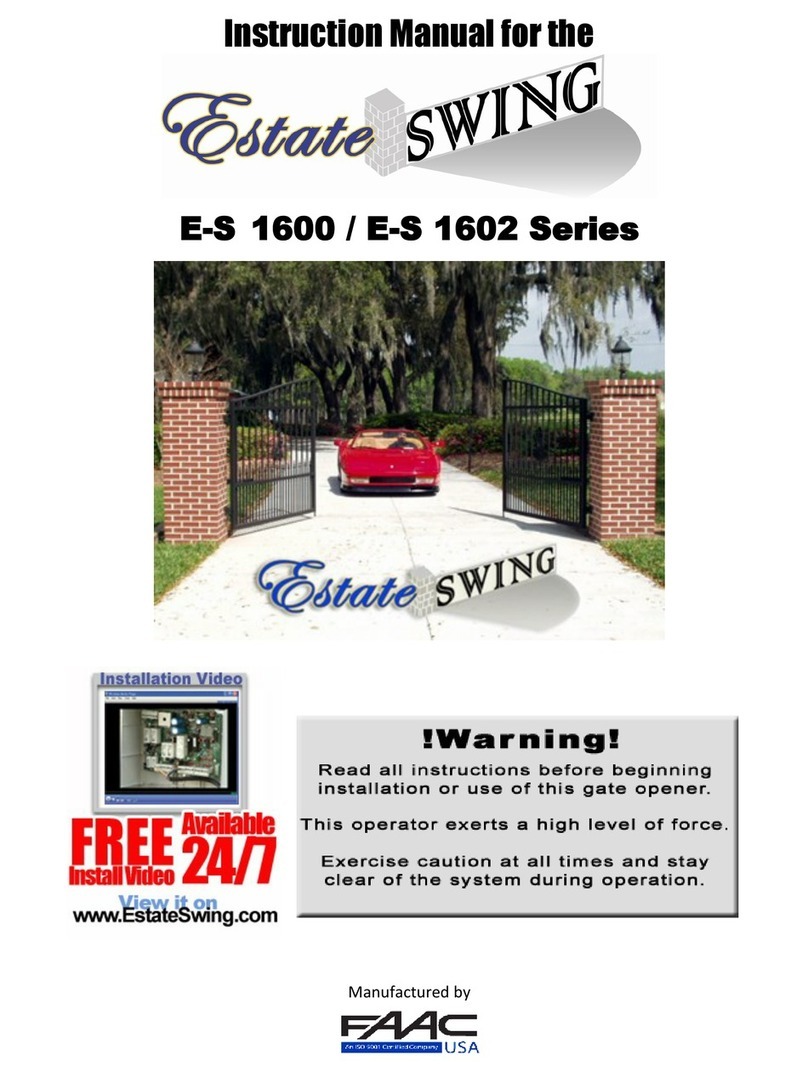
Estate Swing
Estate Swing E-S 1600 Series User manual
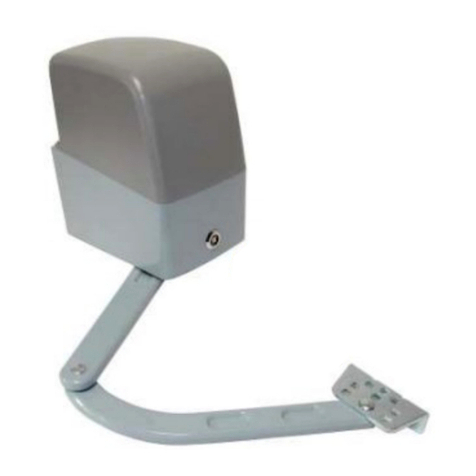
Estate Swing
Estate Swing E-SC 400 User manual

Estate Swing
Estate Swing Classic Series User manual
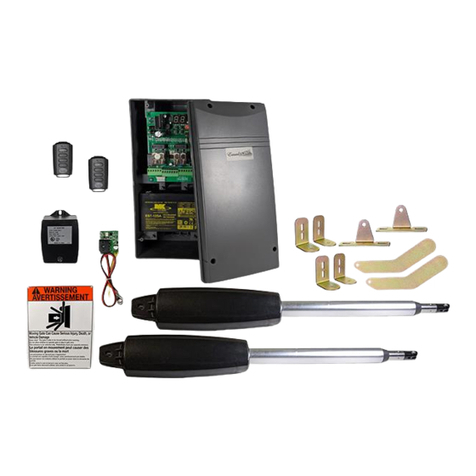
Estate Swing
Estate Swing E-S Allegiant Series User manual
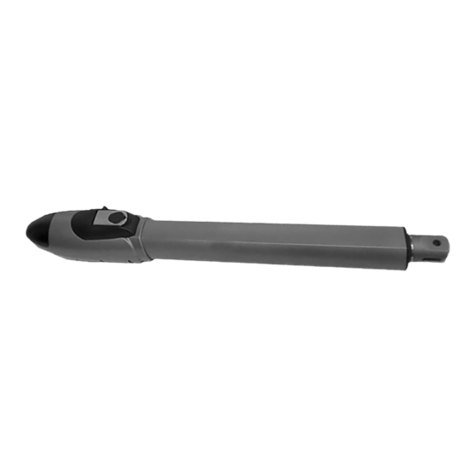
Estate Swing
Estate Swing E-S 1600L Series User manual

Estate Swing
Estate Swing E-S 500 User manual
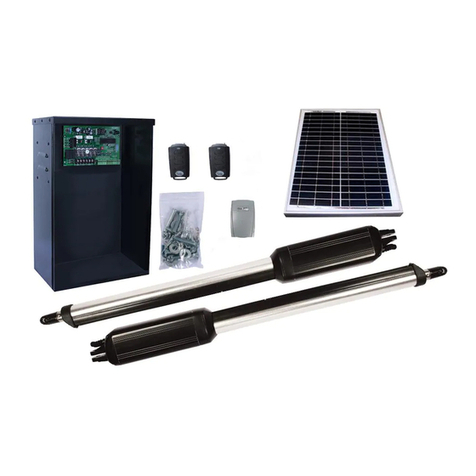
Estate Swing
Estate Swing E-S 1000D Series User manual

Estate Swing
Estate Swing Classic Series User manual

Estate Swing
Estate Swing E-S 300 User manual

Estate Swing
Estate Swing E-SC 1600 Series User manual
